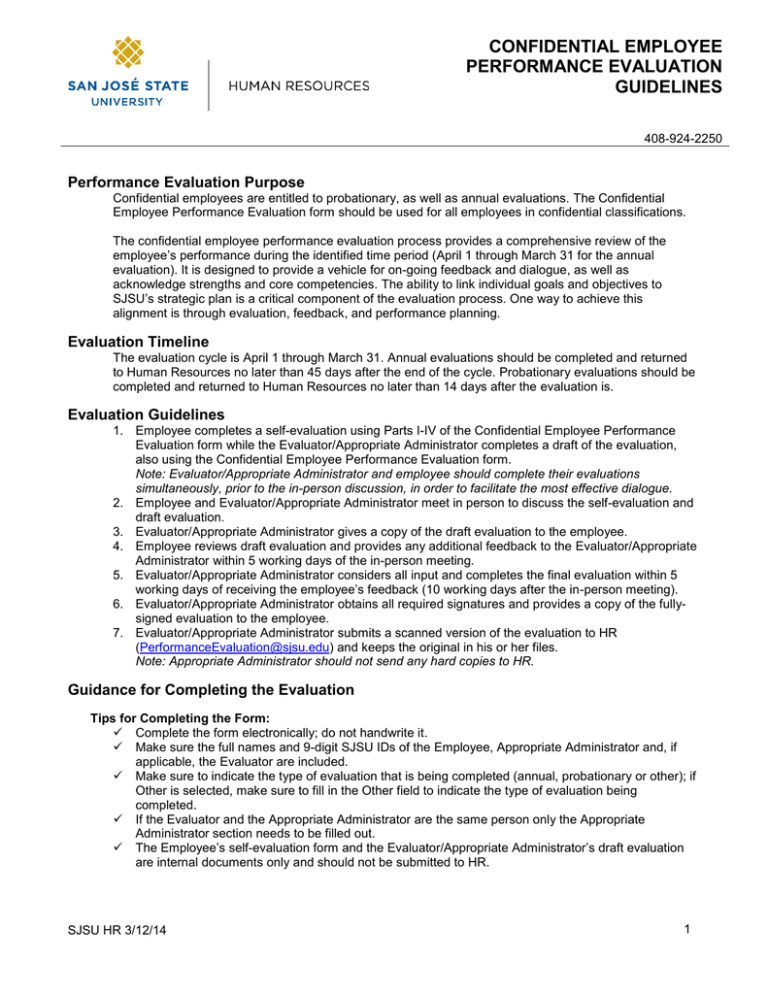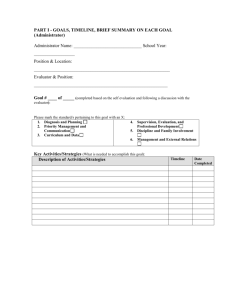CONFIDENTIAL EMPLOYEE PERFORMANCE EVALUATION GUIDELINES
advertisement

CONFIDENTIAL EMPLOYEE PERFORMANCE EVALUATION GUIDELINES 408-924-2250 Performance Evaluation Purpose Confidential employees are entitled to probationary, as well as annual evaluations. The Confidential Employee Performance Evaluation form should be used for all employees in confidential classifications. The confidential employee performance evaluation process provides a comprehensive review of the employee’s performance during the identified time period (April 1 through March 31 for the annual evaluation). It is designed to provide a vehicle for on-going feedback and dialogue, as well as acknowledge strengths and core competencies. The ability to link individual goals and objectives to SJSU’s strategic plan is a critical component of the evaluation process. One way to achieve this alignment is through evaluation, feedback, and performance planning. Evaluation Timeline The evaluation cycle is April 1 through March 31. Annual evaluations should be completed and returned to Human Resources no later than 45 days after the end of the cycle. Probationary evaluations should be completed and returned to Human Resources no later than 14 days after the evaluation is. Evaluation Guidelines 1. Employee completes a self-evaluation using Parts I-IV of the Confidential Employee Performance Evaluation form while the Evaluator/Appropriate Administrator completes a draft of the evaluation, also using the Confidential Employee Performance Evaluation form. Note: Evaluator/Appropriate Administrator and employee should complete their evaluations simultaneously, prior to the in-person discussion, in order to facilitate the most effective dialogue. 2. Employee and Evaluator/Appropriate Administrator meet in person to discuss the self-evaluation and draft evaluation. 3. Evaluator/Appropriate Administrator gives a copy of the draft evaluation to the employee. 4. Employee reviews draft evaluation and provides any additional feedback to the Evaluator/Appropriate Administrator within 5 working days of the in-person meeting. 5. Evaluator/Appropriate Administrator considers all input and completes the final evaluation within 5 working days of receiving the employee’s feedback (10 working days after the in-person meeting). 6. Evaluator/Appropriate Administrator obtains all required signatures and provides a copy of the fullysigned evaluation to the employee. 7. Evaluator/Appropriate Administrator submits a scanned version of the evaluation to HR (PerformanceEvaluation@sjsu.edu) and keeps the original in his or her files. Note: Appropriate Administrator should not send any hard copies to HR. Guidance for Completing the Evaluation Tips for Completing the Form: Complete the form electronically; do not handwrite it. Make sure the full names and 9-digit SJSU IDs of the Employee, Appropriate Administrator and, if applicable, the Evaluator are included. Make sure to indicate the type of evaluation that is being completed (annual, probationary or other); if Other is selected, make sure to fill in the Other field to indicate the type of evaluation being completed. If the Evaluator and the Appropriate Administrator are the same person only the Appropriate Administrator section needs to be filled out. The Employee’s self-evaluation form and the Evaluator/Appropriate Administrator’s draft evaluation are internal documents only and should not be submitted to HR. SJSU HR 3/12/14 1 Suggestions for Providing Meaningful Feedback: Part I: Operational Effectiveness Employees: Review your position description and evaluate how you performed your assignments and job responsibilities; include items you feel you need to improve upon. Think of specific examples where you have excelled and times where your performance could have been better and ask for suggestions and guidance. Be prepared to talk about ways to improve your performance. Let your manager know how he or she can help you be the most effective in your role. Evaluators/Appropriate Administrators: Review the position description and evaluate the employee’s performance as related to assignments and job responsibilities; include items you feel require improvement. Talk with the employee about specific examples where their performance excelled as well as examples when performance could have been better and offer guidance and suggestions. Talk specifically about what you’d like to see the employee improve upon during the next evaluation period and what steps can be taken to make those improvements. Ask the employee how you can help him/her be more effective and successful in their position. Part II: Core Competencies Employees: Review each competency and think about your performance in each area. Think about how your position responsibilities align with each competency and be prepared to talk about how the two fit together. Be prepared to discuss specific examples of how you’ve excelled and where you may need improvement. Evaluators/Appropriate Administrators: Review each competency and think about the employee’s performance in each area. Talk about how position responsibilities align with specific competencies and the importance of both elements as part of the whole. Talk with the employee about each competency and provide specific examples of where they’ve excelled and where you feel development should occur. Part III: Goals Goals should be SMART (see below) and should align with position responsibilities, core competencies and the university’s strategic plan. Specific Measurable Actionable Reasonable Time-bound Employees: Review the goals stated on your last evaluation and determine whether or not they were achieved. Be prepared to discuss why a goal may not have been achieved and think about whether it needs to remain a goal for the next evaluation period. Think about additional goals you want to set for the next evaluation period and be prepared to discuss your rationale for setting specific goals. Evaluators/Appropriate Administrators: Review the employee’s goals from the last evaluation and determine whether or not they were achieved. Think about the goals you wish to set for the next evaluation period and how the employee might achieve them. Part IV: Overall Evaluation Employees: SJSU HR 3/12/14 2 Think about your overall performance and determine which of the four evaluation criteria most accurately reflects your performance during the evaluation period. This should be a comprehensive evaluation of your performance in both the position responsibilities and core competencies. Be prepared to discuss items that need improvement and think about how you can take steps toward that improvement. Evaluators/Appropriate Administrators: Look at the employee’s overall performance and determine which of the four evaluation criteria most accurately reflects his or her performance during the evaluation period. This should be a comprehensive evaluation of the employee’s performance in both the position responsibilities and core competencies. Be prepared to discuss items that need improvement and think about how you can help the employee take steps toward that improvement. Part V: Performance Improvement Plan (if applicable) Employees: This section should not be completed as part of the self-evaluation. Evaluators/Appropriate Administrators: If you have evaluated the employee as Improvement Needed (Below Satisfactory) in part(s) I and/or II of the form, it is recommended that you complete an Improvement Plan and discuss it with the employee. Email a scanned copy of the Improvement Plan to PerformanceEvaluation@sjsu.edu for inclusion in the personnel file. Part VI: Draft Evaluation Employees: This section should not be completed as part of the self-evaluation. You should sign this section once the in-person conversation has taken place and you have received a copy of the draft evaluation. Evaluators/Appropriate Administrators: This section should be completed during the in-person meeting the Employee and the Evaluator/Appropriate Administrator. o The ‘Date evaluation was discussed with the employee’ field should be the date of the inperson meeting. o The ‘Date input is due to the evaluator’ field should be 5 work days from the in-person meeting. o The ‘Date final evaluation is due to the employee’ field should be 10 work days from the inperson meeting. Make sure the Evaluator’s name is typed in this section; he or she should sign once the in-person conversation has taken place. The signed draft evaluation should be given to the employee. Part VII: Final Review Employees: This section should not be completed as part of the self-evaluation. You should sign this section once you have been given the final evaluation. Your signature indicates receipt of the final copy of the evaluation. It does not necessarily indicate agreement with its content. Yours should be the final signature on the final evaluation. Evaluators/Appropriate Administrators: Make sure the Evaluator and Appropriate Administrator’s names, if not the same person, are typed in this section. The Evaluator and Appropriate Administrator (if not the Evaluator) should sign the final evaluation prior to it being given to the employee. Provide the employee with the signed final copy of the evaluation for his or her signature then scan the fully signed document and email it to PerformanceEvaluation@sjsu.edu. Provide the employee SJSU HR 3/12/14 3 with a copy of the fully signed document and keep the original for your files. Do not email the selfevaluation, the draft evaluation or the position description. SJSU HR 3/12/14 4
